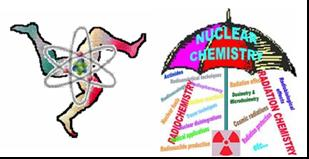Speaker
Prof.
Ignazio Renato Bellobono
(LASA, Department of Physics, University of Milan, and B.I.T. srl, Milan, Italy)
Description
In the first part of the presentation, some epistemological thoughts related to the connection between CHEMISTRY and RADIOCHEMISTRY are introduced.
About 40 years before the birth of RADIOCHEMISTRY, a great debate was taking course in CHEMISTRY, concerning the essence itself of this new-born science, from the question of atomic and molecular weights to periodical properties of the elements and their compounds. Even if about further four decades before, the Avogrado’s principle, based on Gay-Lussac’s work, had been established, a great confusion existed. The first to have envisaged the potentiality of Avogadro’s principle and its correctness has been a young researcher, Stanislao Cannizzaro, born in Palermo (July 13 th 1826), who won the chair of chemistry in 1855, at the University of Genoa. In this University, he published in 1858 Sunto di un Corso di Filosofia Chimica, in which he gave the outmost value to Avogadro’s principle, by considering that if two gases, in the same temperature and pressure state, contain the same number of molecules, the ratio of their two volumes gives directly the ratio of their molecular weights (what we now call formula weights).
During the presentation of these principles by Cannizzaro, four years after Avogado’s death, at the first International Congress of Chemistry of Karlsrule, in 1860, where also Dmitrij Ivanovič Mendeléev and Julius Lothar Meyer were present, the latter addressed to Cannizzaro a well known appreciation (you gave us back our sight). Interpretation of CHEMISTRY on the light of Periodic Table of elements was the necessary presupposition, 36 years later, to the birth of RADIOCHEMISTRY .
Two cases of epistemological significance of pseudo-discoveries in the history of Radioactivity are then considered, the first one concerning Ausonium, Hesperium, and the discovery of nuclear fission, the second one connected to contamination by containers and to the eternal dream of alchemists, trying to convert lead or mercury into gold. Cameron and Ramsay (Le Radium, 1907, 4, 402) irradiated, by alpha particles, a very pure (or what they deemed so) aqueous solution, containing copper (II) nitrate and sulphate, and observed, by spectroscopy, the formation of traces of lithium, of neon, and of more considerable quantities of sodium. Their interpretation has been that radiochemical decomposition of copper (II) took place by this way.
One year later, Marie Curie (M. Curie, E. Gleditsch, Le Radium, 1908, 5, 225) showed that it is extremely difficult, by operating in glass or quartz containers, to obtain distilled water rigorously free of lithium. By repeating the experiments of Cameron and Ramsay in platinum containers, no lithium nor sodium could be detected. A lesson for all radiochemists.
Primary author
Prof.
Ignazio Renato Bellobono
(LASA, Department of Physics, University of Milan, and B.I.T. srl, Milan, Italy)




